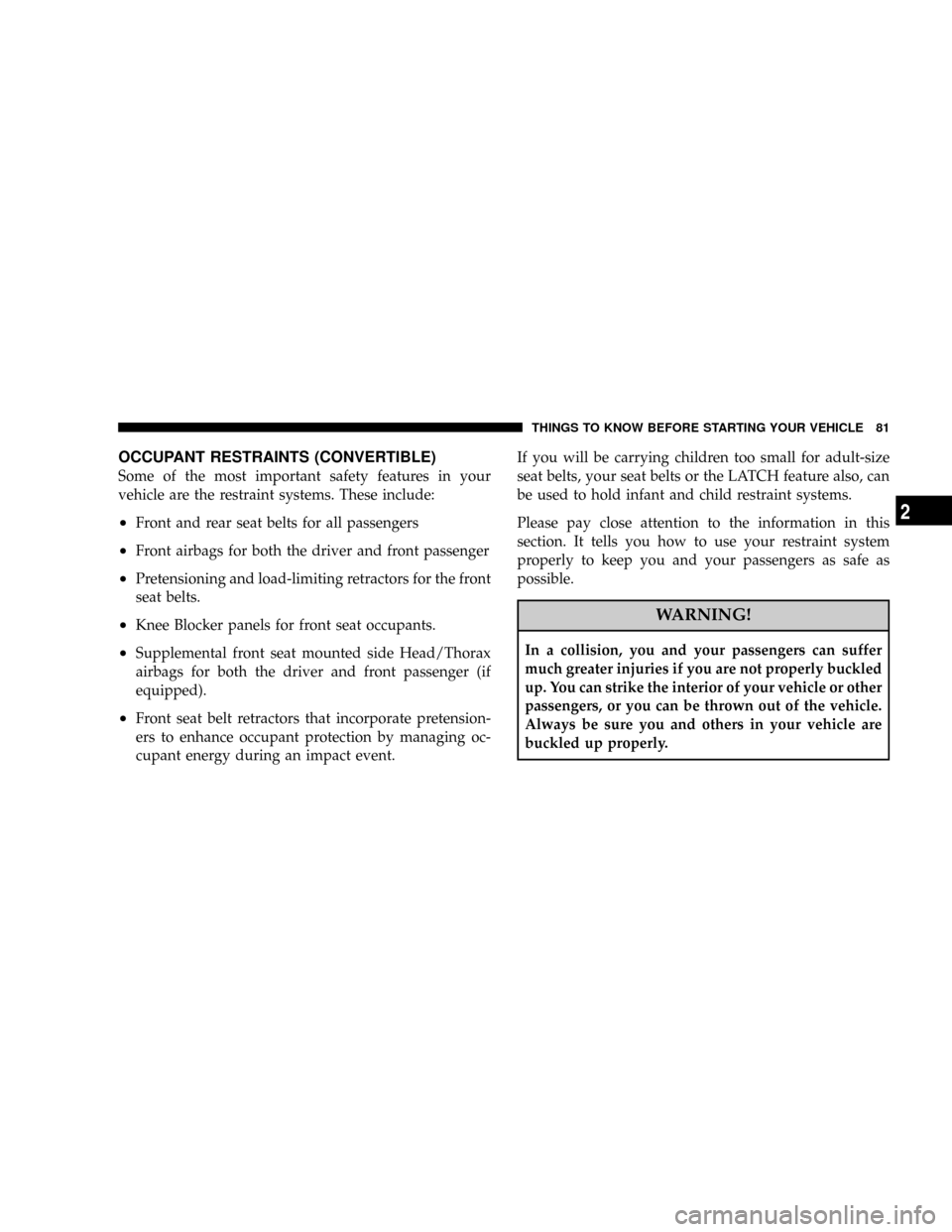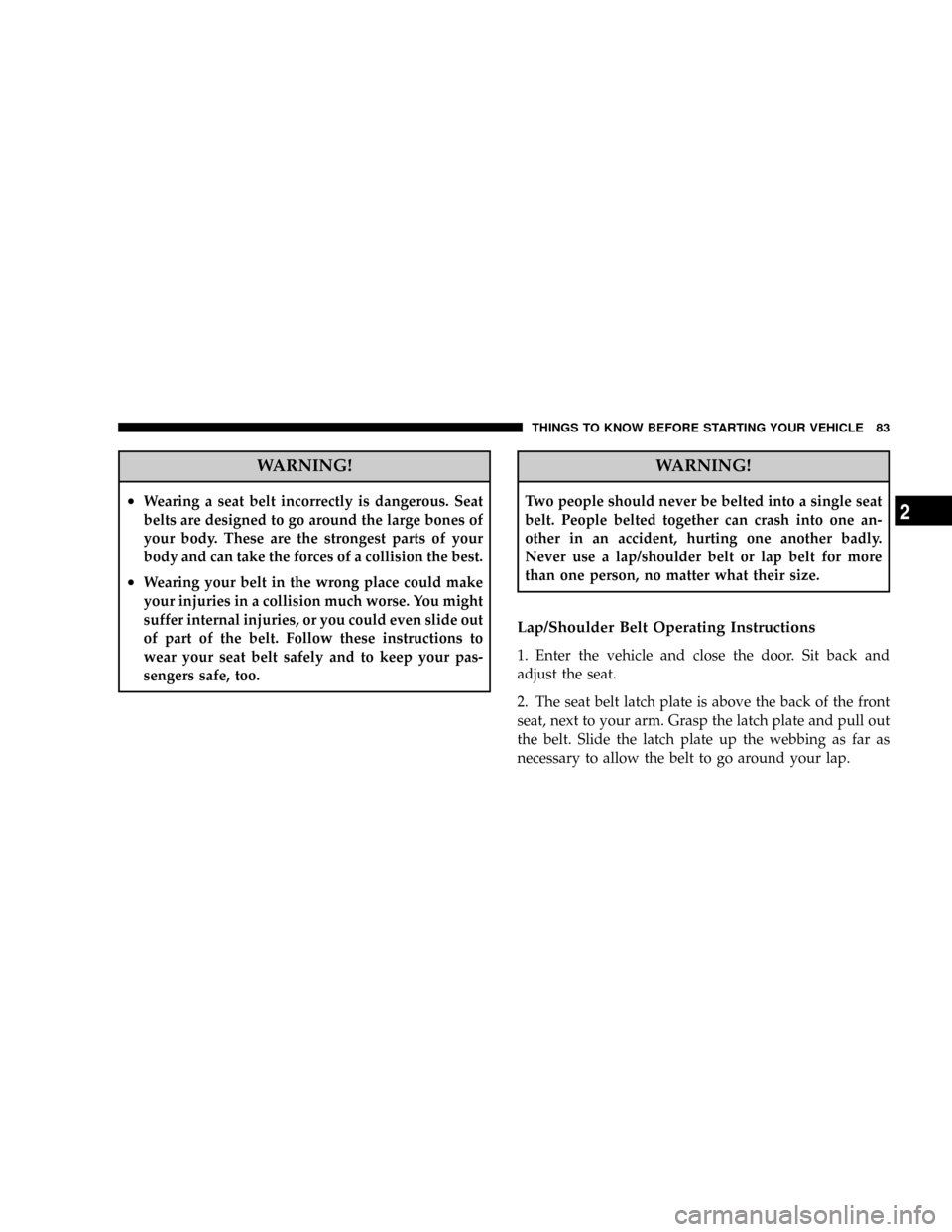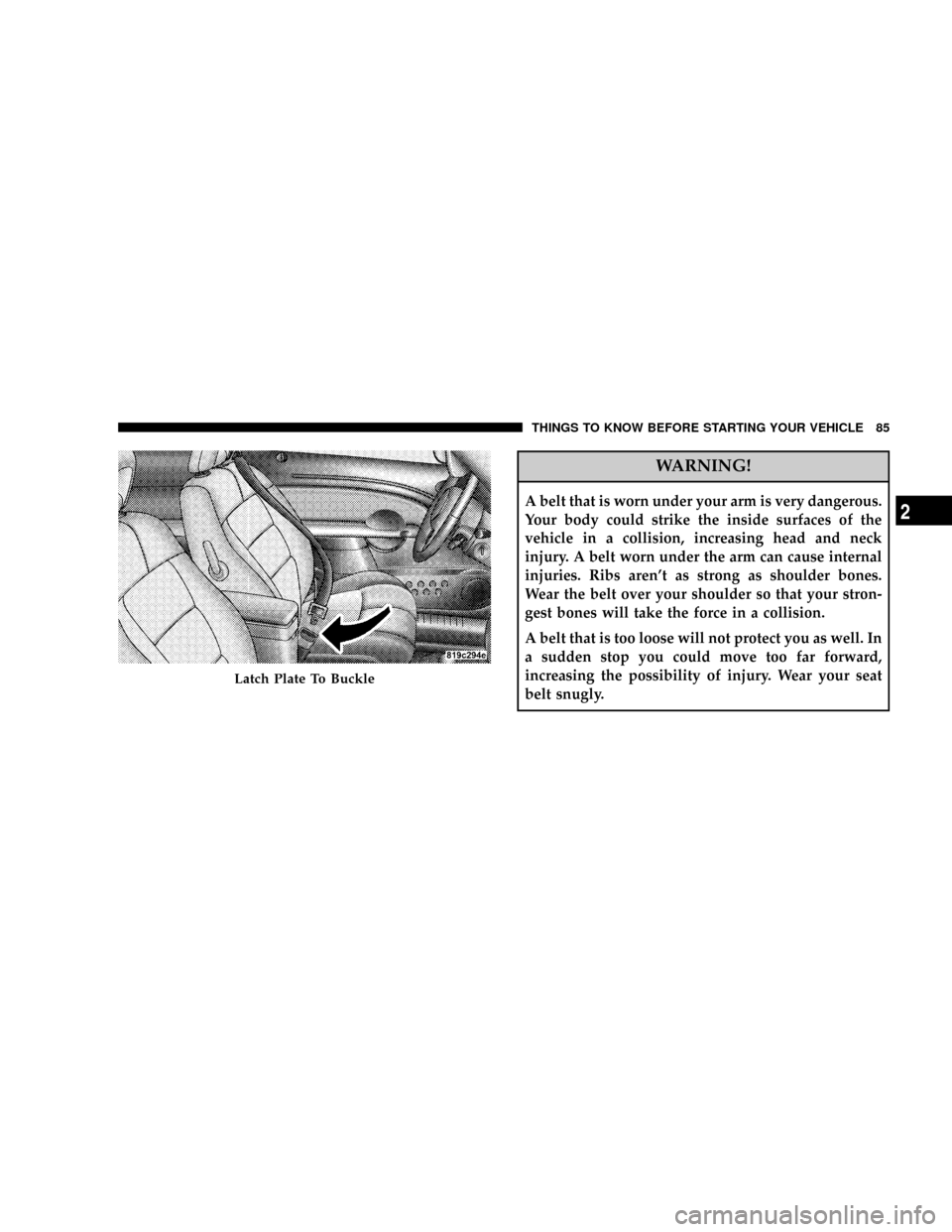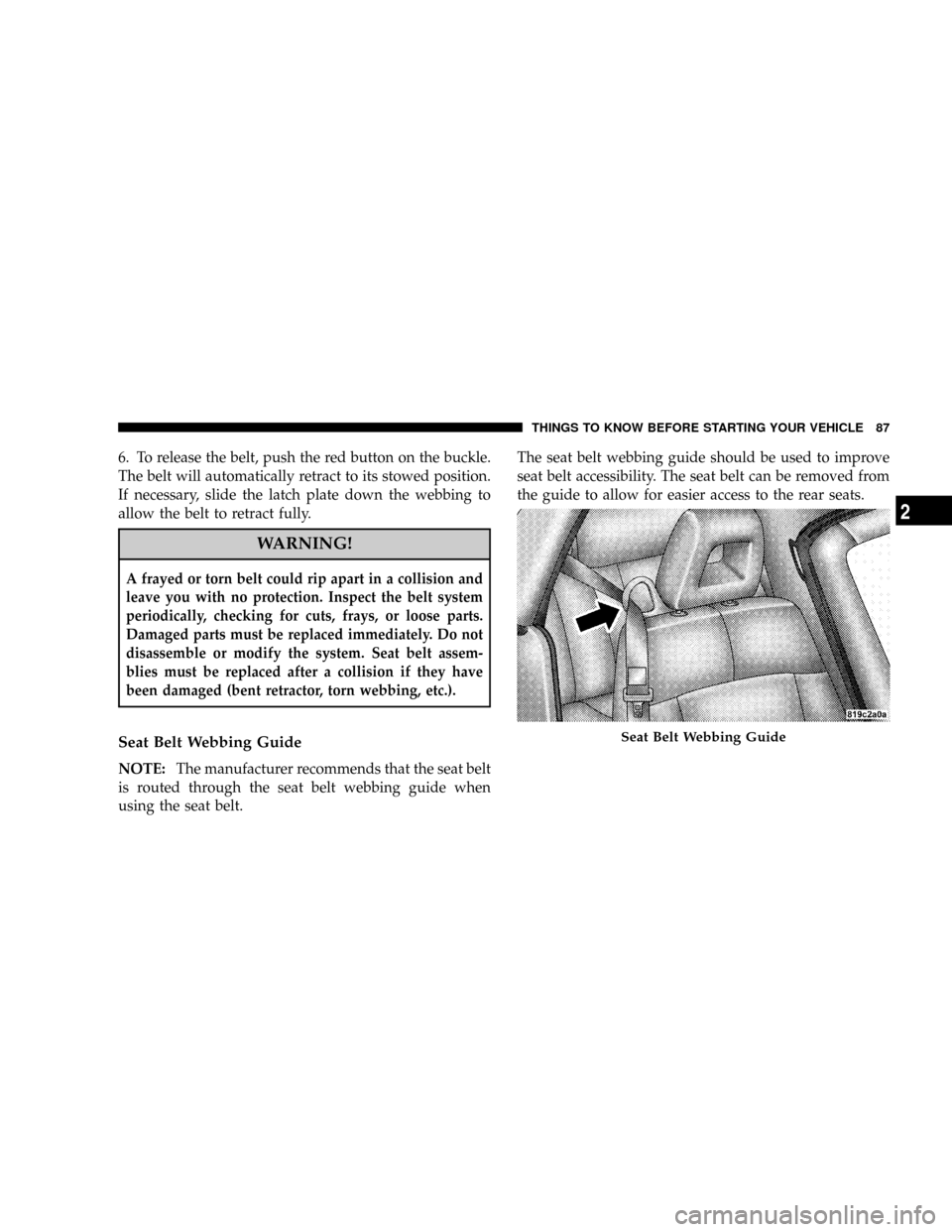CHRYSLER PT CRUISER 2008 1.G Manual Online
Manufacturer: CHRYSLER, Model Year: 2008, Model line: PT CRUISER, Model: CHRYSLER PT CRUISER 2008 1.GPages: 488, PDF Size: 7.43 MB
Page 81 of 488

OCCUPANT RESTRAINTS (CONVERTIBLE)
Some of the most important safety features in your
vehicle are the restraint systems. These include:
²Front and rear seat belts for all passengers
²Front airbags for both the driver and front passenger
²Pretensioning and load-limiting retractors for the front
seat belts.
²Knee Blocker panels for front seat occupants.
²Supplemental front seat mounted side Head/Thorax
airbags for both the driver and front passenger (if
equipped).
²Front seat belt retractors that incorporate pretension-
ers to enhance occupant protection by managing oc-
cupant energy during an impact event.If you will be carrying children too small for adult-size
seat belts, your seat belts or the LATCH feature also, can
be used to hold infant and child restraint systems.
Please pay close attention to the information in this
section. It tells you how to use your restraint system
properly to keep you and your passengers as safe as
possible.
WARNING!
In a collision, you and your passengers can suffer
much greater injuries if you are not properly buckled
up. You can strike the interior of your vehicle or other
passengers, or you can be thrown out of the vehicle.
Always be sure you and others in your vehicle are
buckled up properly.
THINGS TO KNOW BEFORE STARTING YOUR VEHICLE 81
2
Page 82 of 488

Buckle up even though you are an excellent driver, even
on short trips. Someone on the road may be a poor driver
and cause a collision that includes you. This can happen
far away from home or on your own street.
Research has shown that seat belts save lives, and they
can reduce the seriousness of injuries in a collision. Some
of the worst injuries happen when people are thrown
from the vehicle. Seat belts reduce the possibility of
ejection and the risk of injury caused by striking the
inside of the vehicle.Everyone in a motor vehicle should
be belted at all times.
LAP/SHOULDER BELTS
All the seats in your vehicle are equipped with Lap/
Shoulder Belts.
The belt webbing retractor is designed to lock during
very sudden stops or collisions. This feature allows the
shoulder part of the belt to move freely with you undernormal conditions. But in a collision, the belt will lock
and reduce the risk of your striking the inside of the
vehicle or being thrown out.
WARNING!
²It is extremely dangerous to ride in a cargo area,
inside or outside of a vehicle. In a collision, people
riding in these areas are more likely to be seri-
ously injured or killed.
²Do not allow people to ride in any area of your
vehicle that is not equipped with seats and seat
belts.
²Be sure everyone in your vehicle is in a seat and
using a seat belt properly.
82 THINGS TO KNOW BEFORE STARTING YOUR VEHICLE
Page 83 of 488

WARNING!
²Wearing a seat belt incorrectly is dangerous. Seat
belts are designed to go around the large bones of
your body. These are the strongest parts of your
body and can take the forces of a collision the best.
²Wearing your belt in the wrong place could make
your injuries in a collision much worse. You might
suffer internal injuries, or you could even slide out
of part of the belt. Follow these instructions to
wear your seat belt safely and to keep your pas-
sengers safe, too.
WARNING!
Two people should never be belted into a single seat
belt. People belted together can crash into one an-
other in an accident, hurting one another badly.
Never use a lap/shoulder belt or lap belt for more
than one person, no matter what their size.
Lap/Shoulder Belt Operating Instructions
1. Enter the vehicle and close the door. Sit back and
adjust the seat.
2. The seat belt latch plate is above the back of the front
seat, next to your arm. Grasp the latch plate and pull out
the belt. Slide the latch plate up the webbing as far as
necessary to allow the belt to go around your lap.
THINGS TO KNOW BEFORE STARTING YOUR VEHICLE 83
2
Page 84 of 488

WARNING!
A shoulder belt placed behind you will not protect
you from injury during a collision. You are more
likely to hit your head in a collision if you do not
wear your shoulder belt. The lap and shoulder belt
are meant to be used together.
3. When the belt is long enough to fit, insert the latch
plate into the buckle until you hear a ªclick.º
Removing Slack From Belt
84 THINGS TO KNOW BEFORE STARTING YOUR VEHICLE
Page 85 of 488

WARNING!
A belt that is worn under your arm is very dangerous.
Your body could strike the inside surfaces of the
vehicle in a collision, increasing head and neck
injury. A belt worn under the arm can cause internal
injuries. Ribs aren't as strong as shoulder bones.
Wear the belt over your shoulder so that your stron-
gest bones will take the force in a collision.
A belt that is too loose will not protect you as well. In
a sudden stop you could move too far forward,
increasing the possibility of injury. Wear your seat
belt snugly.
Latch Plate To Buckle
THINGS TO KNOW BEFORE STARTING YOUR VEHICLE 85
2
Page 86 of 488

4. Position the lap belt across your thighs, below your
abdomen. To remove slack in the lap belt portion, pull up
on the shoulder belt. To loosen the lap belt if it is too tight,
tilt the latch plate and pull on the lap belt. A snug belt
reduces the risk of sliding under the belt in a collision.WARNING!
²A lap belt worn too high can increase the risk of
internal injury in a collision. The belt forces won't be
at the strong hip and pelvic bones, but across your
abdomen. Always wear the lap belt as low as pos-
sible and keep it snug.
²A twisted belt can't do its job as well. In a collision
it could even cut into you. Be sure the belt is straight.
If you can't straighten a belt in your vehicle, take it to
your dealer and have it fixed.
5. Position the shoulder belt on your chest so that it is
comfortable and not resting on your neck. The retractor
will withdraw any slack in the belt.
Removing Slack From Belt
86 THINGS TO KNOW BEFORE STARTING YOUR VEHICLE
Page 87 of 488

6. To release the belt, push the red button on the buckle.
The belt will automatically retract to its stowed position.
If necessary, slide the latch plate down the webbing to
allow the belt to retract fully.
WARNING!
A frayed or torn belt could rip apart in a collision and
leave you with no protection. Inspect the belt system
periodically, checking for cuts, frays, or loose parts.
Damaged parts must be replaced immediately. Do not
disassemble or modify the system. Seat belt assem-
blies must be replaced after a collision if they have
been damaged (bent retractor, torn webbing, etc.).
Seat Belt Webbing Guide
NOTE:The manufacturer recommends that the seat belt
is routed through the seat belt webbing guide when
using the seat belt.The seat belt webbing guide should be used to improve
seat belt accessibility. The seat belt can be removed from
the guide to allow for easier access to the rear seats.
Seat Belt Webbing Guide
THINGS TO KNOW BEFORE STARTING YOUR VEHICLE 87
2
Page 88 of 488

LAP/SHOULDER SEAT BELT UNTWISTING
PROCEDURE
Use the following procedure to untwist a twisted lap/
shoulder belt.
1. Position the latch plate as close as possible to the
anchor point.
2. At about six to twelve inches (15 to 30 cm) above the
latch plate, grasp and twist the belt webbing 180É to
create a fold that begins immediately above the latch
plate.
3. Slide the latch plate upward over the folded webbing.
The folded webbing must enter the slot at the top of the
latch plate.
4. Continue to slide the latch plate up until it clears the
folded webbing.
SEAT BELT PRETENSIONERS
The seat belts for both front seating positions are
equipped with pretensioning devices that are designed to
remove slack from the seat belt in the event of a collision.
These devices improve the performance of the seat belt
by assuring that the belt is tight about the occupant early
in a collision. Pretensioners work for all size occupants,
including those in child restraints.
NOTE:These devices are not a substitute for proper seat
belt placement by the occupant. The seat belt still must be
worn snugly and positioned properly.
The pretensioners are triggered by the front airbag con-
trol module (see Airbag Section). Like the front airbags,
the pretensioners are single use items. After a collision
that is severe enough to deploy the airbags and preten-
sioners, both must be replaced.
88 THINGS TO KNOW BEFORE STARTING YOUR VEHICLE
Page 89 of 488

ENHANCED SEAT BELT REMINDER SYSTEM
(BELTALERTT)
If the driver's or front passenger's seat belt has not been
buckled within 60 seconds of starting the vehicle and if
the vehicle speed is greater than 5 mph (8 km/h), the
Enhanced Warning System (BeltAlertt) will alert the
driver or front passenger to buckle their seat belt. The
driver should also instruct all other occupants to buckle
their seat belts. Once the warning is triggered, the
Enhanced Warning System (BeltAlertt) will continue to
chime and flash the Seat Belt Warning Light for 96
seconds or until the driver's or front passenger's seat belt
is buckled. The Enhanced Warning System (BeltAlertt)
will be reactivated if the driver's or front passenger's seat
belt is unbuckled for more than 10 seconds and the
vehicle speed is greater than 5 mph (8 km/h).NOTE:
²The Enhanced Warning System (BeltAlertt) can be
enabled or disabled by your authorized dealer.
²DaimlerChrysler does not recommend deactivating
the Enhanced Warning System (BeltAlertt).
If the Enhanced Warning System (BeltAlertt) is deacti-
vated, the Seat Belt Warning Light will continue to
illuminate while the driver seat belt remains unfastened.
SEAT BELTS AND PREGNANT WOMEN
We recommend that pregnant women use the seat belts
throughout their pregnancy. Keeping the mother safe is
the best way to keep the baby safe.
Pregnant women should wear the lap part of the belt
across the thighs and as snug across the hips as possible.
Keep the belt low so that it does not come across the
abdomen. That way the strong bones of the hips will take
the force if there is a collision.
THINGS TO KNOW BEFORE STARTING YOUR VEHICLE 89
2
Page 90 of 488

DRIVER AND FRONT PASSENGER
SUPPLEMENTAL RESTRAINT SYSTEM (SRS)
This vehicle has airbags for both the driver and front
passenger as a supplement to the seat belt restraint
systems. The driver's front airbag is mounted in the
center of the steering wheel. The passenger's front airbag
is mounted in the instrument panel, above the glove
compartment. The words SRS AIRBAG are embossed on
the airbag covers.
Front Panel SRS Features
1 Ð Driver Airbag 3 Ð Passenger Knee Blocker
2 Ð Passenger Airbag 4 Ð Driver Knee Blocker 90 THINGS TO KNOW BEFORE STARTING YOUR VEHICLE